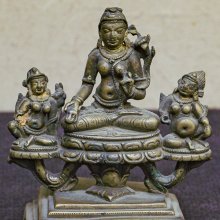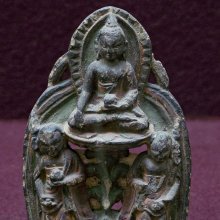Sahita: 18 definitions
Introduction:
Sahita means something in Buddhism, Pali, Hinduism, Sanskrit, Jainism, Prakrit, Marathi, Hindi. If you want to know the exact meaning, history, etymology or English translation of this term then check out the descriptions on this page. Add your comment or reference to a book if you want to contribute to this summary article.
Images (photo gallery)
(+40 more images available)
In Hinduism
Shaktism (Shakta philosophy)
Source: Google Books: ManthanabhairavatantramSahitā (सहिता) refers to “she who is accompanied (by the Goddess Bhagavatī)”, according to the Manthānabhairavatantra, a vast sprawling work that belongs to a corpus of Tantric texts concerned with the worship of the goddess Kubjikā.—Accordingly, “She who is KLĪṂ, the goddess Klinnā, accompanied (sahitā) by the Goddess (bhagavatī) and endowed with the consciousness of the Command is Vakrā whose form is the Triangle. Supreme with (the sacred energy of the) nasal (letters in her Vidyā), she is Parā, the foremost knowledge. She has three eyes. (As) the Sun and Moon she shines as the Ray (of divine light), and is the goddess called Ciñciṇī. I praise her, she who residing in the Void, is the goddess whose eyes are the Sun and Moon and consists of thirty-two syllables”.

Shakta (शाक्त, śākta) or Shaktism (śāktism) represents a tradition of Hinduism where the Goddess (Devi) is revered and worshipped. Shakta literature includes a range of scriptures, including various Agamas and Tantras, although its roots may be traced back to the Vedas.
In Buddhism
Tibetan Buddhism (Vajrayana or tantric Buddhism)
Source: OSU Press: Cakrasamvara SamadhiSahita (सहित) refers to the “unity” (of cow-dung and water), according to the Guru Mandala Worship (maṇḍalārcana) ritual often performed in combination with the Cakrasaṃvara Samādhi, which refers to the primary pūjā and sādhanā practice of Newah Mahāyāna-Vajrayāna Buddhists in Nepal.—Accordingly, “Charity (is) cow dung and water united (sahita), moral conduct and cleansing, Patience, taking away tiny ants, heroism, bringing forth the religious rite. Meditation, single-minded in each moment, wisdom, splendidly clear lines, These perfections, six indeed are gained, having made the Muni’s maṇḍala”.

Tibetan Buddhism includes schools such as Nyingma, Kadampa, Kagyu and Gelug. Their primary canon of literature is divided in two broad categories: The Kangyur, which consists of Buddha’s words, and the Tengyur, which includes commentaries from various sources. Esotericism and tantra techniques (vajrayāna) are collected indepently.
In Jainism
General definition (in Jainism)
Source: The University of Sydney: A study of the Twelve ReflectionsSahita (सहित) refers to the “possessed (of the fire of anger)”, according to the 11th century Jñānārṇava, a treatise on Jain Yoga in roughly 2200 Sanskrit verses composed by Śubhacandra.—Accordingly, “Alone [the living soul] who is very wise becomes a god [like] a bee on a lotus [like] the face of a woman . Alone, being cut by swords, he appropriates a hellish embryo. Alone the one who is ignorant, driven by the fire of anger, etc. [com.—kopāgni-sahita—‘possessed of the fire of anger’], does action. Alone [the living soul] enjoys the empire of knowledge in the avoidance of all mental blindness. [Thus ends the reflection on] solitariness”.
Synonyms: Kalita.

Jainism is an Indian religion of Dharma whose doctrine revolves around harmlessness (ahimsa) towards every living being. The two major branches (Digambara and Svetambara) of Jainism stimulate self-control (or, shramana, ‘self-reliance’) and spiritual development through a path of peace for the soul to progess to the ultimate goal.
Languages of India and abroad
Pali-English dictionary
Source: BuddhaSasana: Concise Pali-English Dictionarysahita : (adj.) accompanied with; united; keeping together; consistent. (nt.), literature; scriptures; a piece of wood to generate fire by rubbing on.
Source: Sutta: The Pali Text Society's Pali-English DictionarySahita, (pp. of saṃ+dhā, cp. Sk. sahita=saṃhita) 1. accompanied with Mhvs 7, 27.—2. united, keeping together D. I, 4; J. IV, 347; Pug. 57.—3. consistent, sensible, to the point D. I, 8; A. II, 138; IV, 196; S. III, 12; Dh. 19 (at DhA. I, 157 explained as a name for the Tipiṭaka, thus equalling Sk. saṃhita); Pug. 42.—4. close together, thick Th. 2, 254.—araṇisahita (nt.) firewood and appurtenances Vin. II, 217; D. II, 340 sq.; J. I, 212; DhA. II, 246.—sahitaṃvata (adj.) having a consistent or perpetual vow, i.e. living the holy life J. V, 320 (=sīlācāra-sampanna C.); VI, 525 (T. sahitabbata; C. explains as samādinna-vata gahita-tāpasa-vesa). Kern, Toev. II. 51 takes it as a corrupted Sk. śaṃsita-vrata. (Page 701)

Pali is the language of the Tipiṭaka, which is the sacred canon of Theravāda Buddhism and contains much of the Buddha’s speech. Closeley related to Sanskrit, both languages are used interchangeably between religions.
Marathi-English dictionary
Source: DDSA: The Molesworth Marathi and English Dictionarysahita (सहित).—p (S) Accompanied by; associated with; being in company with, 2 Borne, endured, suffered. 3 Used as prep Along with, with.
Source: DDSA: The Aryabhusan school dictionary, Marathi-Englishsahita (सहित).—p Accompanied by. Borne, suffered. prep With.
Marathi is an Indo-European language having over 70 million native speakers people in (predominantly) Maharashtra India. Marathi, like many other Indo-Aryan languages, evolved from early forms of Prakrit, which itself is a subset of Sanskrit, one of the most ancient languages of the world.
Sanskrit dictionary
Source: DDSA: The practical Sanskrit-English dictionarySahita (सहित).—a.
1) Accompanied or attended by, together with, united or associated with; पवनाग्निसमागमो ह्ययं सहितं ब्रह्म यदस्त्रतेजसा (pavanāgnisamāgamo hyayaṃ sahitaṃ brahma yadastratejasā) R.8.4.
2) Borne, endured.
3) (In astr.) Being in conjunction with.
-tam A bow weighing 3 Palas.
-tam ind. Together with, with.
Source: Cologne Digital Sanskrit Dictionaries: Edgerton Buddhist Hybrid Sanskrit DictionarySahita (सहित).—adj. (1) (= Pali id.) of speech, connected, coherent, sensible: Mahāvyutpatti 474 (°tā, of Buddha's speech); sahitaṃ ca bhūtaṃ (true) ca sadā prabhāṣate Saddharmapuṇḍarīka 373.4; sahitaṃ…sumadhuraṃ…abravīt Mahāvastu i.145.7 = 201.7 = ii.5.2 (Senart i.490 wrongly kindly, agreeable); Mūla-Sarvāstivāda-Vinaya ii.174.2 (read) tavāsahitam, mama sahitam; (2) of hair and eyebrows, in sahita-bhrū Lalitavistara 107.8 and sahita-keśa 12, both in list of anuvyañjana of the Buddha (Senart also reads sahita-keśa in Mahāvastu ii.44.10, but read with mss. ahasita-keśa, q.v.); Tibetan Lalitavistara both times mñam pa = even, which usually renders Sanskrit sama and has both mgs., alike, and level, flat, smooth; probably therefore with smooth (orig. connected, so close-growing; perhaps thick?) eyebrows and hair. These terms seem to be substitutions for, and roughly equivalent to, ślakṣṇa-bhrū and -keśa of other texts (Nos. 65 and 76 of my list of anuvyañjana), both of which are lacking in Lalitavistara. In Pali, Therīg. 254, sahita is used of a young woman's hair compared to a grove: kānanaṃ va sahitaṃ (commentary 210.7 ghanasaṃnivesaṃ uddham eva uṭṭhita-uddhadīghasākhaṃ upavanaṃ viya; in accordance with this Mrs. Rhys Davids renders dense).
Source: Cologne Digital Sanskrit Dictionaries: Shabda-Sagara Sanskrit-English DictionarySahita (सहित).—mfn.
(-taḥ-tā-taṃ) 1. Accompanied by, in company with, associated with, &c. 2. Borne, endured. 3. Sincerely. n. Adv.
(-taṃ) With, together with. E. saha with, itac aff.; or ṣah to bear, kta aff., with iṭ augment; or sa with, hita useful, right, &c.
Source: Cologne Digital Sanskrit Dictionaries: Benfey Sanskrit-English DictionarySahita (सहित).—i. e. 2. saha + ita, adj. 1. Accompanied by; at the end of comp. words, With, [Hitopadeśa] 61, 4. 2. With (with instr.),
Sahita (सहित).—[adjective] united, joined ([plural] ±sarve all); accompanied by, endowed or furnished with ([instrumental] or —°); [neuter] [adverb] together.
Source: Cologne Digital Sanskrit Dictionaries: Monier-Williams Sanskrit-English Dictionary1) Sahita (सहित):—[from sah] 1. sahita mfn. (for 2. See p. 1195, col. 1) borne, endured, supported, [Horace H. Wilson]
2) [from saha] 2. sahita mf(ā.)n. (for 1. See p. 1193, col. 2) = saṃhita (cf. [Pāṇini 6-1, 144], [vArttika] 1, [Patañjali]), joined, conjoined, united ([dual number] ‘both together’; [plural] [also with sarve], ‘all t°’)
3) [v.s. ...] accompanied or attended by, associated or connected with, possessed of ([instrumental case] or [compound]), [Mahābhārata; Kāvya literature] etc.
4) [v.s. ...] attached or cleaving to, [Kātyāyana-śrauta-sūtra]
5) [v.s. ...] being quite near, [ib.; Mahābhārata]
6) [v.s. ...] (in [astronomy]) being in conjunction with (instr, or [compound]), [Varāha-mihira’s Bṛhat-saṃhitā]
7) Sahitā (सहिता):—[from sahita > saha] f. Name of a river, [Viṣṇu-purāṇa]
8) Sahita (सहित):—[from saha] n. a bow weighing 300 Palas, [cf. Lexicographers, esp. such as amarasiṃha, halāyudha, hemacandra, etc.]
9) a See p. 1193, col. 2.
Source: Cologne Digital Sanskrit Dictionaries: Yates Sanskrit-English DictionarySahita (सहित):—[(taḥ-tā-taṃ) a.] Accompanied by, endured. n. With.
Source: DDSA: Paia-sadda-mahannavo; a comprehensive Prakrit Hindi dictionary (S)Sahita (सहित) in the Sanskrit language is related to the Prakrit word: Sahia.
[Sanskrit to German]
Sanskrit, also spelled संस्कृतम् (saṃskṛtam), is an ancient language of India commonly seen as the grandmother of the Indo-European language family (even English!). Closely allied with Prakrit and Pali, Sanskrit is more exhaustive in both grammar and terms and has the most extensive collection of literature in the world, greatly surpassing its sister-languages Greek and Latin.
Hindi dictionary
Source: DDSA: A practical Hindi-English dictionarySahita (सहित):—(ind) with, together with, along with, accompanied by.
...
Kannada-English dictionary
Source: Alar: Kannada-English corpusSahita (ಸಹಿತ):—[adjective] including; consisting of; accompanying or accompanied by.
--- OR ---
Sahita (ಸಹಿತ):—
1) [noun] that which is good, helpful, salubrious, etc.
2) [noun] that which includes, consists of, accompanying or accompanied by (something or someone).
--- OR ---
Sahita (ಸಹಿತ):—[adverb] along with; together with.
Kannada is a Dravidian language (as opposed to the Indo-European language family) mainly spoken in the southwestern region of India.
See also (Relevant definitions)
Starts with: Sahitabba, Sahitaka, Sahitakumbhaka, Sahitam, Sahitamahaka, Sahitangula, Sahitanguli, Sahitar, Sahitasthita, Sahitatva, Sahitavya.
Ends with (+27): Abhisahita, Abhyantara-siddhi-sahita, Agnisahita, Animeshavali, Anusahita, Anutsahita, Aputra-sahita, Aranisahita, Asahita, Asitasahita, Bhuta-bhavishyad-vartamana-nihshesha-adatya-sahita, Caitanyasahita, Curnasahita, Durutsahita, Gaurisahita, Hatotsahita, Jana-dhana-sahita, Karnasahita, Kirtipratapabalasahita, Kotisahita.
Full-text (+97): Sahitam, Asahita, Sahitya, Sahia, Sahitatva, Rupakusala Citta, Sahitasthita, Salambana, Nidhi-nikshepa-sahita, Sahitakumbhaka, Samasta-utpatti-sahita, Abhyantara-siddhi-sahita, Vamphaya, Sarv-aya-sahita, Sim-antargata-vastu-sahita, Cakitam, Varshneyasahita, Anushvadha, Sathutkara, Sahitoru.
Relevant text
Search found 67 books and stories containing Sahita, Sahitā; (plurals include: Sahitas, Sahitās). You can also click to the full overview containing English textual excerpts. Below are direct links for the most relevant articles:
Garga Samhita (English) (by Danavir Goswami)
Verse 3.6.27 < [Chapter 6 - The Test of Śrī Kṛṣṇa]
Verse 6.7.15 < [Chapter 7 - The Marriage of Śrī Rukmiṇī]
Verse 5.5.7 < [Chapter 5 - Śrī Kṛṣṇa’s Entrance Into Mathurā]
Sahitya-kaumudi by Baladeva Vidyabhushana (by Gaurapada Dāsa)
Text 2.29 < [Chapter 2 - The Natures of Words (śabda)]
Text 4.21 < [Chapter 4 - First-rate Poetry]
Text 2.17 < [Chapter 2 - The Natures of Words (śabda)]
Dhammapada (Illustrated) (by Ven. Weagoda Sarada Maha Thero)
Verse 19-20 - The Story of Two Friends < [Chapter 1 - Yamaka Vagga (Twin Verses)]
List of Mahabharata tribes (by Laxman Burdak)
Shrimad Bhagavad-gita (by Narayana Gosvami)
Verse 9.1 < [Chapter 9 - Rāja-guhya-yoga (Yoga through the most Confidential Knowledge)]
Atharvaveda and Charaka Samhita (by Laxmi Maji)
The Sarvaroga-bhaiṣajya hymns < [Chapter 3 - Diseases and Remedial measures (described in Atharvaveda)]
Treatment to neutralize Poison < [Chapter 3 - Diseases and Remedial measures (described in Atharvaveda)]
Treatment of Apvā disease (Jalodara or Dropsy) < [Chapter 3 - Diseases and Remedial measures (described in Atharvaveda)]





